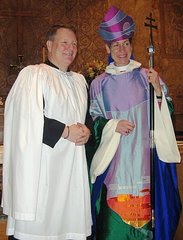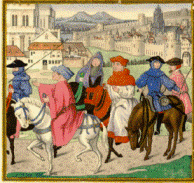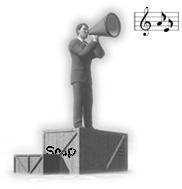Here are some pics from Canterbury that relate to Thomas Beckett, and the attack on his cult and shrine by Henry VIII...
 This is the site of the actual martyrdom in 1170. On this spot, just off the Cathedral Cloister and Chapter House, Thomas Becket was slain by men from the court of Henry II.
This is the site of the actual martyrdom in 1170. On this spot, just off the Cathedral Cloister and Chapter House, Thomas Becket was slain by men from the court of Henry II. Originally, Thomas Becket was buried in a fairly simple tomb in the crypt of the cathedral. Almost immediately his cult began to develop. This is a detail from one of Canterbury's stained glass windows known as the 'Miracle Window' because it documents some of the miracles associated with Thomas Becket's tomb. What it also documents is what the original tomb in the crypt may have looked like. Notice the holes in the side of the tomb. It's believed that these openings allowed pilgrims to touch Becket's coffin, with their hands, feet, and even their heads, to seek a blessing or cure from the saint.
Originally, Thomas Becket was buried in a fairly simple tomb in the crypt of the cathedral. Almost immediately his cult began to develop. This is a detail from one of Canterbury's stained glass windows known as the 'Miracle Window' because it documents some of the miracles associated with Thomas Becket's tomb. What it also documents is what the original tomb in the crypt may have looked like. Notice the holes in the side of the tomb. It's believed that these openings allowed pilgrims to touch Becket's coffin, with their hands, feet, and even their heads, to seek a blessing or cure from the saint.  Eventually, a magnificent shrine to the saint was built upstairs in the Trinity Chapel at the east end of the cathedral on the spot pictured above. It might have looked something like the photo of Edward the Confessor's shrine in Westminster Abbey below. It is believed that the openings allowing access to the saint's coffin were maintained. It was believed to have been build of rose colored stone and to have become heavily jeweled as pilgrims and patrons made gifts of precious metals and stones to the shrine.
Eventually, a magnificent shrine to the saint was built upstairs in the Trinity Chapel at the east end of the cathedral on the spot pictured above. It might have looked something like the photo of Edward the Confessor's shrine in Westminster Abbey below. It is believed that the openings allowing access to the saint's coffin were maintained. It was believed to have been build of rose colored stone and to have become heavily jeweled as pilgrims and patrons made gifts of precious metals and stones to the shrine. Edward the Confessor's shrine in Westminster Abbey.
Edward the Confessor's shrine in Westminster Abbey. The shrine stood in the Trinity Chapel from 1220 until 1538 when its destruction was ordered by Henry VIII -- just over 300 years. During those 300 years, the tomb of Thomas Becket was the focus of intense devotion and pilgrimage. It is to the tomb of Thomas Becket at Canterbury that Chaucer's pilgrims are travelling as they tell each other their Canterbury Tales. Here in the floor stones of the Trinity Chapel, you can see where the knees of 300 years of pilgrims have smoothed the rough stone, creating a dip in the stones where they knelt beside the shrine.
The shrine stood in the Trinity Chapel from 1220 until 1538 when its destruction was ordered by Henry VIII -- just over 300 years. During those 300 years, the tomb of Thomas Becket was the focus of intense devotion and pilgrimage. It is to the tomb of Thomas Becket at Canterbury that Chaucer's pilgrims are travelling as they tell each other their Canterbury Tales. Here in the floor stones of the Trinity Chapel, you can see where the knees of 300 years of pilgrims have smoothed the rough stone, creating a dip in the stones where they knelt beside the shrine.  Another view of the floor in the Trinity Chapel where the shrine of Thomas Becket once stood. This shot is taken from the northeast corner of the spot where the shrine once stood. The dip worn by the pilgrims' knees is clearly visible.
Another view of the floor in the Trinity Chapel where the shrine of Thomas Becket once stood. This shot is taken from the northeast corner of the spot where the shrine once stood. The dip worn by the pilgrims' knees is clearly visible. The stone used in the shrine is believed to have been rose colored marble. As the jewels and precious metals on the tomb were harvested for the royal treasury in 1538 -- including the Regale of France, a huge ruby offered to Becket's memory by Louis VII which became a part of a thumb ring worn by Henry VIII, the stone itself was tossed aside. Pieces of rose colored stone believed to have been part of the shrine are still found from time to time at the cathedral when excavations and renovations are made. These two pieces of rose stone are in the cathedral archive.
The stone used in the shrine is believed to have been rose colored marble. As the jewels and precious metals on the tomb were harvested for the royal treasury in 1538 -- including the Regale of France, a huge ruby offered to Becket's memory by Louis VII which became a part of a thumb ring worn by Henry VIII, the stone itself was tossed aside. Pieces of rose colored stone believed to have been part of the shrine are still found from time to time at the cathedral when excavations and renovations are made. These two pieces of rose stone are in the cathedral archive. Over the course of centuries some of the discarded rose colored stone has been refashioned and used in various structures of the cathedral. This piece of rose colored stone was used to pave the cathedral cloister.
Over the course of centuries some of the discarded rose colored stone has been refashioned and used in various structures of the cathedral. This piece of rose colored stone was used to pave the cathedral cloister. Thomas Becket's memory is still honored today by priests and publicans in Canterbury.
Thomas Becket's memory is still honored today by priests and publicans in Canterbury.






No comments:
Post a Comment